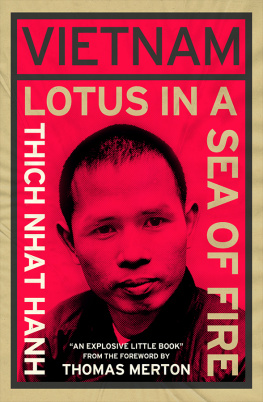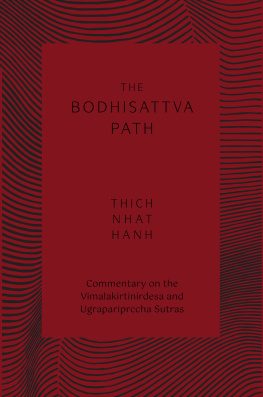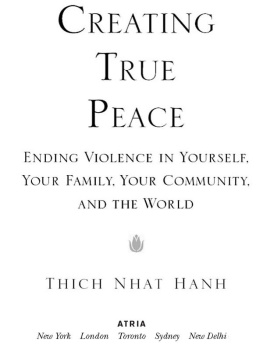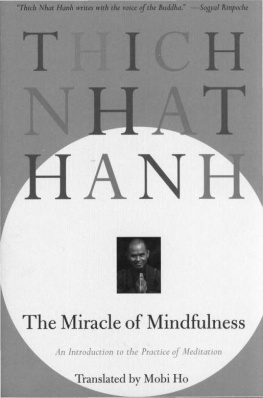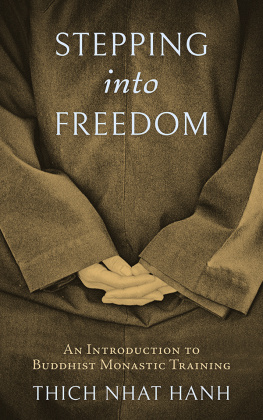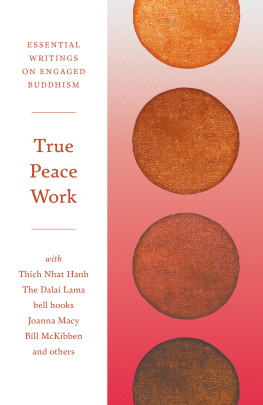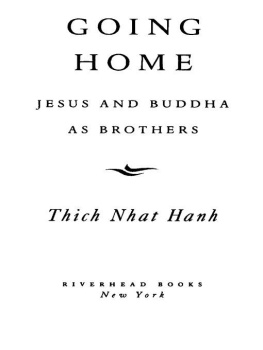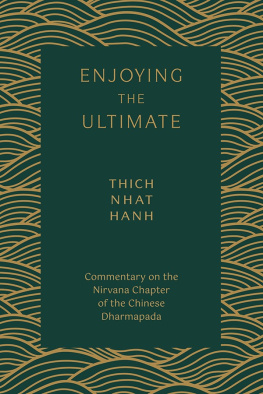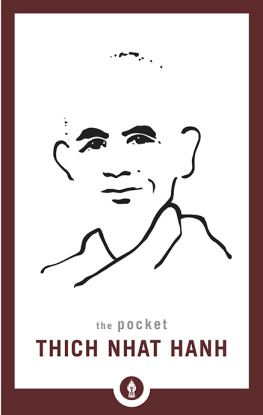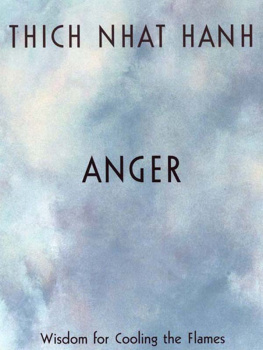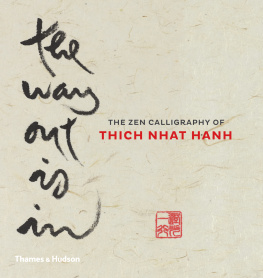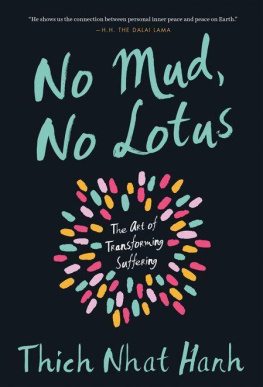
Parallax Press
2236B Sixth Street
Berkeley, CA 94710
parallax.org
Parallax Press is the publishing division of Plum Village Community of Engaged Buddhism, Inc.
1967, 2022 Plum Village Community of Engaged Buddhism, Inc.
All rights reserved
First edition published in 1967 by Hill and Wang, Inc., an imprint of Farrar, Straus, and Giroux.
Printed in the United States of America
Cover photograph of Thich Nhat Hanh in 1966 by permission of Getty Images
Cover design by Matt Broughton
Text design by Katie Eberle and Happenstance Type-O-Rama
Author photograph Plum Village Community of Engaged Buddhism
ISBN 9781952692031
E-book ISBN 9781952692048
Library of Congress Cataloging-in-Publication Data
Names: Nht Hnh, Thch, author. | Merton, Thomas, 1915-1968, writer of
foreword. | Hassler, Alfred, 1910-1991, writer of afterword.
Title: Vietnam : lotus in a sea of fire / Thich Nhat Hanh ; first edition
foreword by Thomas Merton ; afterword by Alfred Hassler ; second edition
foreword by Rev. Gregory Kosen Snyder.
Description: Second edition. | Berkeley, California : Parallax Press,
[2022] | First edition published in 1967 by Hill and Wang, Inc., an
imprint of Farrar, Straus, and Giroux.
Identifiers: LCCN 2022001626 (print) | LCCN 2022001627 (ebook) | ISBN
9781952692031 (trade paperback) | ISBN 9781952692048 (ebook)
Subjects: LCSH: Vietnam War, 1961-1975--Religious aspects--Buddhism. |
Buddhism and politics--Vietnam (Republic) | Buddhism and state--Vietnam
(Republic) | Religion and state--Vietnam (Republic) | Vietnam
(Republic)--Politics and government.
Classification: LCC DS559.64 .N43 2022 (print) | LCC DS559.64 (ebook) |
DDC 959.704/31--dc23/eng/20220311
LC record available at https://lccn.loc.gov/2022001626
LC ebook record available at https://lccn.loc.gov/2022001627
Also by Thich Nhat Hanh
- Fragrant Palm Leaves: Journals 19621967
- Good Citizens: Creating Enlightened Society
- Interbeing: The 14 Mindfulness Trainings of Engaged Buddhism, 4th Edition
- Love in Action: Writings on Nonviolent Change
- Love Letter to the Earth
- The Mindfulness Survival Kit: Five Essential Practices
- The World We Have: A Buddhist Approach to Peace and Ecology
- Zen and the Art of Saving the Planet
Lin pht l trung thp.
The jade burned on the mountain retains its natural color,
The lotus, blooming in the furnace, does not lose its freshness.
Ngo An, Vietnamese Zen monk, eleventh century CE
Introduction
A Path of Peace Forged in Fire
In 1967 when Vietnam: Lotus in a Sea of Fire was first published in English, Thich Nhat Hanh was a forty-one-year-old monk who was unknown to most English-speaking audiences. Today he is remembered affectionately as Thay (teacher), the senior Zen master of the Order of Interbeing, the founder of the international Plum Village community, and the spiritual teacher for hundreds of thousands across the world. He is far more than a monk within a particular school of Buddhism. Forged in the colonial fires of war in Vietnam, his teachings on the practice of peace have changed our culture at the deepest level. For turning the whole of his life toward cultivating peace in human hearts and bodies everywhere, Thich Nhat Hanh is felt by many around the world to have been a manifestation of an awakened Bodhisattva in our time.
By the time this book was first released, its author had studied at a traditional Buddhist academy, the University of Saigon, Princeton Theological Seminary, Columbia University, and Union Theological Seminary. As Union and Columbias religious studies department automatically co-registered their students in the early 1960s, Thay was enrolled in and is an alumnus of both schools; hence the naming of Unions Thich Nhat Hanh Program for Engaged Buddhism after him. In many cases, he was a lecturer alongside his studies. In addition to being fluent in Vietnamese, English, and French, he was already deeply familiar with the Buddhist languages of Classical Chinese, Sanskrit, and Pali. He had founded La Boi Publishing House, the Van Hanh Buddhist University in Saigon, and the School of Youth for Social Service, a corps of Buddhist peace workers who built and rebuilt clinics, schools, and villages throughout Vietnam. In an effort to change the response of the institution of Vietnamese Buddhism to the suffering of his country, he had founded the Order of Interbeing and coined the term Bouddhisme engag, opening a new dharmic path for Buddhists of his country and the world.
For those who have been introduced to Thay through his teachings on breath, mindfulness, and interbeing, the nuanced, unflinching historical and political analysis filling the pages of this book may feel unlike anything you have read from him. Here we have a savvy political and historical analyst who has intimately lived the colonial occupation of France and the United States. He witnessed firsthand the crushing violence all around him, helped guide the response of the Buddhist community and Vietnamese people, and eventually became the foremost advocate for a third way toward peaceful resolution of the war.
As this is a book that addresses the history, context, and potential resolution of a war that ended nearly fifty years ago, we might believe it was written for another age. However, we would be grossly mistaken. In the original foreword, the Trappist monk Thomas Merton laments: One of the great tragedies of our time is that in our desperate incapacity to cope with the complexities of our world, we oversimplify every issue and reduce it to a neat ideological formula. Sadly, this tragedy has not lessened. The compassionate care of life that so requires the kind of analytical and practical nuance found in these pages is still often reductionistic or set aside for the sake of widespread greed and political expediency. To act compassionately in a confused and violent world, we must understand our shared suffering. To know this suffering, we must clarify its causes.
This is a book that deeply considers polarized violence, detailing historical contexts and contemporary realities to find a way through entrenched political dualisms so a peaceful solution might put an end to the mass killing of life. Whether it be passionate disagreements over what is factual, entrenched political ideologies rooted in clashing moral visions, or the exploitative ebbs and flows of empire shrugged off as the necessities of realpolitik, we are caught in a world of antagonisms that take life every day and threaten the very ground of our human existence. As such, we desperately need the kind of example this book skillfully provides to better inform this moment.
This book carries deeply personal meaning for me in this regard. As a very young man, my father was a soldier in Vietnam. He suffered greatly during the war and that pain came home with him. It would not be an exaggeration to say the war in Vietnam was a silent member of our family, an impenetrable curtain surrounding many of the more confusing aspects of my childhood. As someone who became a Buddhist in early adulthood, I have found a personally healing path in Thays insistence on holding all those who suffered in this war in the heart of his teaching. In At Hells Gate: A Soldiers Journey from War to Peace, I recall Claude Anshin Thomass powerful account of his time at Plum Village and how terrifying and transformative it was for him to be accepted with love by those in whose country he had been a helicopter gunner. The perspective Thay takes in this book
Next page
